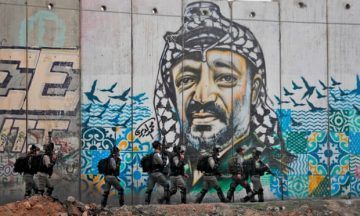Ben Ehrenreich in The Guardian:
 Not far from the monstrous checkpoint at Qalandia – the main gateway through which the Israeli military controls the passage of human beings between Ramallah and Jerusalem – is a small, outdoor, stonecutters’ workshop, one of hundreds scattered throughout the West Bank. Whatever may be happening at the checkpoint, at least one worker can usually be seen standing in the stone-cutters’ yard, his face, hair and clothes caked with the same white dust that covers the high concrete wall and the watchtower, where it mixes with the black smoke and char from burning tyres and the molotov cocktails that local youths, on particularly bad days, hurl at the checkpoint and barrier that confine them.
Not far from the monstrous checkpoint at Qalandia – the main gateway through which the Israeli military controls the passage of human beings between Ramallah and Jerusalem – is a small, outdoor, stonecutters’ workshop, one of hundreds scattered throughout the West Bank. Whatever may be happening at the checkpoint, at least one worker can usually be seen standing in the stone-cutters’ yard, his face, hair and clothes caked with the same white dust that covers the high concrete wall and the watchtower, where it mixes with the black smoke and char from burning tyres and the molotov cocktails that local youths, on particularly bad days, hurl at the checkpoint and barrier that confine them.
When visitors to the region write about stones, they tend to focus on the ones that Palestinian youth fling at armed and armoured soldiers. And on the more deadly projectiles the soldiers shoot back. It’s easy to get lost in that melee. Andrew Ross is neither distracted nor enthralled by such emblematic scenes. He is more interested in the stone-cutter who usually remains outside the photo’s frame. Through him and others like him, Ross examines the unseen structures of expropriation and exploitation that undergird the occupation as effectively as all those walls and guns. Stone Men can be dry, lithic even, but it consistently provides insights into the troubled and troubling relationships between Israelis and Palestinians that are hard to come by elsewhere. Above all, it is a history of labour. Palestine sits on reserves of high-quality limestone valued at $20bn, and the business of quarrying, cutting and dressing it provides more private sector jobs than any other industry in the West Bank.
More here.
